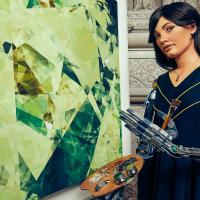Neil Harbisson is an artist and the world’s first legally-recognized cyborg. He was born colorblind, but with the help of a doctor who remains anonymous, Neil biohacked his brain by implanting an antenna so he could experience the world in full color.
“Biohacking” for Beginners
Biohacking is essentially do-it-yourself biology. The more moderate side of biohacking entails attempting to optimize the body’s functions with health supplements. Even something as pedestrian as drinking a cup of coffee to boost your energy can be considered a basic biohack.
But on the more extreme side of the biohacking movement, you’ll find hackers who are also known as “grinders.” Grinders make physical modifications to their bodies with surgeries. There is a variety of implants available including chips, magnets, wireless routers, and compasses. Grinders also create new implants and body modifications all the time.
Grinders operate in a legal gray area. In the U.S., hacker surgeons refer to their work as “extreme body modification,” rather than surgery. Neil doesn’t reveal the identity of his doctor, as it would risk the loss of his medical license.
The practice isn’t guaranteed to be safe. In fact, many devices and novel biocompatible coatings are being tested for the first time on humans by biohacker-surgeons. They bypass traditional channels of medicine because, to grinders, the benefits are worth the risks.
Grinders also think of themselves as transhumanists. Like Neil, transhumanists add advanced technology to their bodies via implantation to enhance their mental, sensory, or physical abilities. They no longer identify as 100% human, but as modified beings with advanced capabilities.
From Grayscale to a Vibrant World
Neil Harbisson was born with a condition called complete achromatopsia. It’s a rare form of color blindness that occurs due to specific genetic mutations that prevent the retina’s cones, which are responsible for processing color, from functioning properly. Achromatopsia affects only one in 30,000 people.
It means that, unlike other forms of color blindness with which people can distinguish some colors, Neil’s eyes see the world in infinite shades of gray, black, and white. Without being able to see color, Neil grew up obsessed with it.
When doctors told him there weren’t any treatments available, he started thinking about whether he could come up with another way to “see” color. He looked to nature for answers and was inspired when he saw antenna-clad insects that could sense their surroundings.
Neil worked with various specialists to design his antenna-like implant and its software. The device consists of a flexible arm with a light sensor attached to the end. The sensor hovers around Neil’s forehead, picking up light and reading wavelengths. A chip that’s implanted against Neil’s skull then translates the corresponding color into a vibration, which he perceives as sound.
Since his successful implant surgery in 2004, Neil has been able to “hear” colors and feel their vibrations. In addition to the complete visible spectrum of color, Neil can also perceive infrared and ultraviolet light, giving him superhuman abilities.
Each color Neil sees is perceived as a note he hears. He says that at first, he had to memorize how the notes he heard corresponded with the colors he was sensing. Now though, his sense of color is second nature. He even dreams in color.
As an artist, Neil jumped on the opportunity to explore the audiovisual manifestations of being a cyborg synesthete. With his unique sense, he transforms paintings into music, faces into sound portraits, and speeches into mesmerizing patterns of colored lines. Since he’s able to hear colors, he can also paint music and translate music into paintings.
What It’s Like Being the First Cyborg on Earth
Being the only person in the world with an antenna hasn’t been all sound-rainbows and Technicolor music. When Neil tried to renew his passport in 2004, he was initially denied because there is a law prohibiting people from being photographed with any electronic equipment in a passport photo.
He responded explaining that he identifies as a cyborg and that his antenna isn’t equipment, but a body part. After a lengthy fight, the U.K. passport authority eventually agreed to approve his status as a cyborg, which made him the first legally-recognized cyborg in the world.
Neil later lost his job as a waiter because his boss told him he could no longer serve customers with his newly acquired appendage. To support himself, he could only do jobs where he worked alone.
Because of his implant, Neil lost his job as a waiter and was initially denied a passport. He now works to protect the rights of cyborgs.
Although he might not be seen at work, he receives plenty of stares in public, but Neil says that he understands. He finds it interesting, as a social experiment, to see how the public perceives unknown technology. Neil wants to help those who feel uneasy about cyborgs to see the world through his eyes.
With fellow artist and biohacker, Moon Ribas, Neil co-founded The Cyborg Foundation to protect the rights of cyborgs and help more people become cyborgs. Instead of promoting artificial intelligence in which technology creates thought, they encourage people to embrace artificial senses where technology gathers stimuli, but human intelligence interprets it.
In the future, Neil hopes that more people will open themselves up to extending their senses and becoming more in touch with the world around them by using technology as part of their bodies. For now, Neil is okay with people giving him a second look because he believes this is just the beginning of a world filled with cyborgs.
For more interesting news about the people and ideas that are changing our world, subscribe to Freethink.


